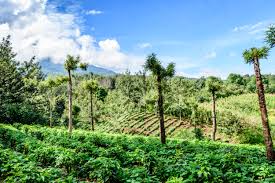Rodriguez and his research are the vanguard of Starbucks’ efforts to adapt.
罗德里格斯及其研究肩负着为星巴克努力适应气候变化冲锋陷阵的重任。
Beginning in 2013, Starbucks decided to invest in growing its footprint in coffee-producing countries.
2013年,星巴克便决定新增投资,扩展其在咖啡生产国的印记。
It now has support centers in nine countries—
到目前为止,该企业的支持中心已经遍布九个国家——
a number Schultz said could triple in the coming years—
舒尔茨说,未来几年内这一数字还能翻两倍——
and a 10-year, $500 million investment fund that supports sustainability programs,
该企业还成立一项为期10年,共计5亿美元的投资基金,用于支持可持续发展项目,
such as adaptation training for farmers and testing new coffee varieties.
比如对农民进行适应性培训,测试新的咖啡品种等。
All this work on the ground in Costa Rica may sound obvious.
哥斯达黎加所有这些实地工作看似平淡无奇。
Companies in sectors from energy to technology invest in research and development to better their products.
为了改进产品,从能源到技术,各个领域的企业都在投资研发。
But the coffee behemoth’s focus on local farms represents a seismic shift.
然而,星巴克这家咖啡巨头聚焦当地农场这一投资角度代表了一次巨变。
Selling coffee to consumers has always been a separate business from growing the beans.
销售咖啡与种植咖啡豆一直是两个独立的行业。
And because an estimated 25 million people farm coffee around the globe,
世界范围内种植咖啡的人数约为2500万人,
big coffee companies have typically found suppliers in whichever place experienced a strong harvest that year.
大型咖啡企业通常都会在当年收成好的地方,无论是何地,寻找供应商。
If one country’s yield suffered, the companies simply looked elsewhere.
某一个国家的咖啡产量受到了影响,到其他国家找也一样。
But with climate change, that supply chain is no longer assured.
然而,随着气候变化,这一供应链便失去了保障。
Arabica coffee—the variety found at Starbucks, Dunkin’ Donuts, McDonald’s and pretty much every other American retailer—
阿拉比卡咖啡——星巴克、唐恩都乐、麦当劳,几乎所有美国零售商都有这种咖啡——
grows in a narrow region of the tropics known as the Coffee Belt, which stretches from Central America to sub-Saharan Africa to Asia.
产自所谓的“咖啡带”,也即热地地区,从中美洲延伸到撒哈拉以南的非洲再到亚洲的一条狭长走廊。
Conditions must be just right or a harvest is lost.
种植条件必须恰到好处,否则就会歉收。

In the past, some areas occasionally experienced of years because of a bad storm or a temperature fluctuation.
过去,因为恶劣风暴或温度波动,一些地区偶尔会出现连年歉收的情形。
Researchers say that in the future such challenges will be constant.
研究人员表示,未来,此类挑战还将持续存在。
Farmers in some regions will be able to adapt by growing at higher elevations, but in others there is nowhere else to go.
一些地区的农民还能换到高海拔地区种植,以此适应气候变化,另一些地区却无处可去。
Entire regions risk becoming unable to continue producing Arabica coffee,
届时,整个地区都将面临无法继续出产阿拉比卡咖啡的风险,
and Schultz and others say there’s no way to make the more resilient Robusta variety,
舒尔茨等人还说,耐性更强的罗布斯塔咖啡也将无法出产,
which is sometimes blended with Arabica to make instant coffee, palatable to the broad coffee-drinking public.
有时,人们会将这种咖啡与阿拉比卡咖啡混合起来,制成为广大咖啡引用人群所接受的速溶咖啡。
Scientists also warn that climate change increases the likelihood of disease, including the dreaded la roya, or stem rust.
科学家还警告说,气候变化还会增加疾病,包括可怕的叶锈病,即茎锈病爆发的可能性。
That disease cut coffee production in Central America by about 15% in the 2012–13 growing year.
2012 - 2013年度,这种疾病就致使中美洲的咖啡产量缩减了15%。
Due in large part to rust, the price of a pound of coffee for consumers in the U.S. jumped roughly 33% between ’11 and ’13.
2011~2013年间,消费者层面一磅咖啡的单价就上涨了约33%,此次上涨很大程度上都是因为茎锈病。
“Climate change is good,” says William Corrales Cruz, a small-coffee-farm owner in the Costa Rican region of Naranjo.
“气候变化倒也是件好事,”哥斯达黎加纳兰霍地区种植咖啡的小农威廉·科拉莱斯·克鲁兹说。
“If you sell rust.”
“如果你卖的是铁锈的话。”
译文由可可原创,仅供学习交流使用,未经许可请勿转载。



